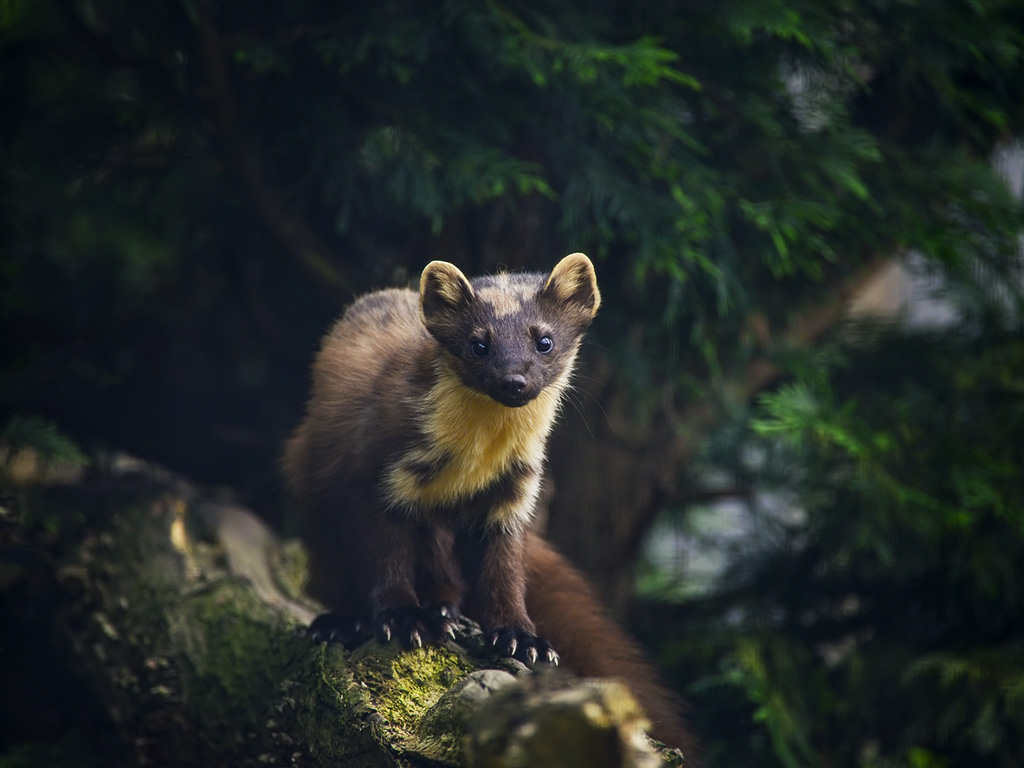
It can seem especially necessary, during bleak times, to count the victories. So when a pine marten was recently sighted in London for the first time in 100 years, the news felt small but momentous. A “richness of pine martens” is even the species’ collective noun.
For far too long Britain has been impoverished by the loss of this magical, foxy, cat-like creature who leaps between trees as easily as a sylph. In the Mesolithic era the species was among Britain’s most common carnivores but hunting and deforestation have decimated its range; by 1915 pine martens survived only in the UK’s more remote reaches. Today, however, they are tentatively expanding again in England and Wales.
On Thursday 8 September it was announced that HogWatch camera trap footage had caught the animal’s bright, startled eyes in woodland in Kingston-upon-Thames. The researchers, who have been using cameras to monitor London’s hedgehog populations since 2016, were astonished to spot its elusive face. “As we become a more urban population, it is exciting to see us able to co-exist again,” said Dr Robin Freeman, of the Zoological Society of London.
The sighting has also not been without a shadow of controversy, however. And the pine marten’s return raises questions about what relationship with nature Britain is ready to have. Do we want a country that teems with long-lost biodiversity, or do we hanker for the Victorian era’s trappings of control?
The tension stems from the fact that Kingston is a long way from the pine marten’s nearest known stronghold in Hampshire. Seventy-odd miles is a substantial distance for a small (40-50cm long) creature to travel. Perhaps this is not a natural recolonisation at all, some have speculated, but an unofficial “rogue release”?
With British wildlife in such a devastated condition, some nature lovers are taking matters into their own hands: 15 per cent of UK species are threatened with extinction, a report by MPs found, yet government funding fell by 30 per cent from 2010 to 2020. So a small number of individuals are now secretly releasing threatened species, from beavers to turtle doves, butterflies to polecats, into new habitats.
The phenomenon is contentious. There are guidelines from the International Union for Conservation of Nature for how to safely re-introduce a species to a new location, conservationists note. These include considerations such as the safety of a new habitat, the sufficiency of its food sources and the ease with which it can be monitored.
Plus there is the human element to consider, with the return of once lost species potentially attracting a backlash. In the case of beavers, British farmers will now be allowed to shoot populations whose dams they believe threaten their crops. Opinion around the return of apex predators such as lynx or wolves is even more divided.
“The preference with any introduction or translocation is that it is done in a properly coordinated, thought-through way,” says Alastair Driver, director of Rewilding Britain. Official pine marten release projects are good examples, he notes, such as that carried out in the Forest of Dean by the Vincent Wildlife Trust.
That said, it is possible that the pine marten spotted in London had come of its own accord from the New Forest, Driver adds. He recalls one tagged male who once made it all the way from mid-Wales to the Peak District in a “very short” amount of time, probably in the process of “cherchez la femme”.
Regardless of its origin therefore, perhaps the overriding message the city’s latest newcomer brings is that there is still time to throw off the past’s disastrous legacy of treating wildlife as something to be fenced in. Where once society privileged game-hunting and fur over the protection of supposed vermin, we are slowly realising that the recovery of this enigmatic species is something to be treasured.
The author Philip Pullman making the pine marten the settled-form of his heroine Lyra’s daemon, Pantalimon, in the His Dark Materials trilogy has arguably helped here. As has the discovery that pine martens are aiding the recovery of the endangered red squirrel (which, as a native species, is better adapted to evading its predation that the non-native grey).
There is of course still much work to do if an ecologically rich and abundant Britain is to be restored. Over the last 70 years half the remaining fragments of ancient woods have been lost and disconnected, making it hard for all species to re-establish themselves. The Prime Minister’s decision last week to remove Zac Goldsmith, a green-minded Conservative peer, from his role as environment minister also bodes ill for wildlife-friendly policy.
But the latest sighting of the fiercely shy, inspiringly resilient pine marten offers a sliver of hope that such a future is still possible. We should seize it.
[See also: Mapped: UK fracking licences could impact one in four Tory constituencies]





